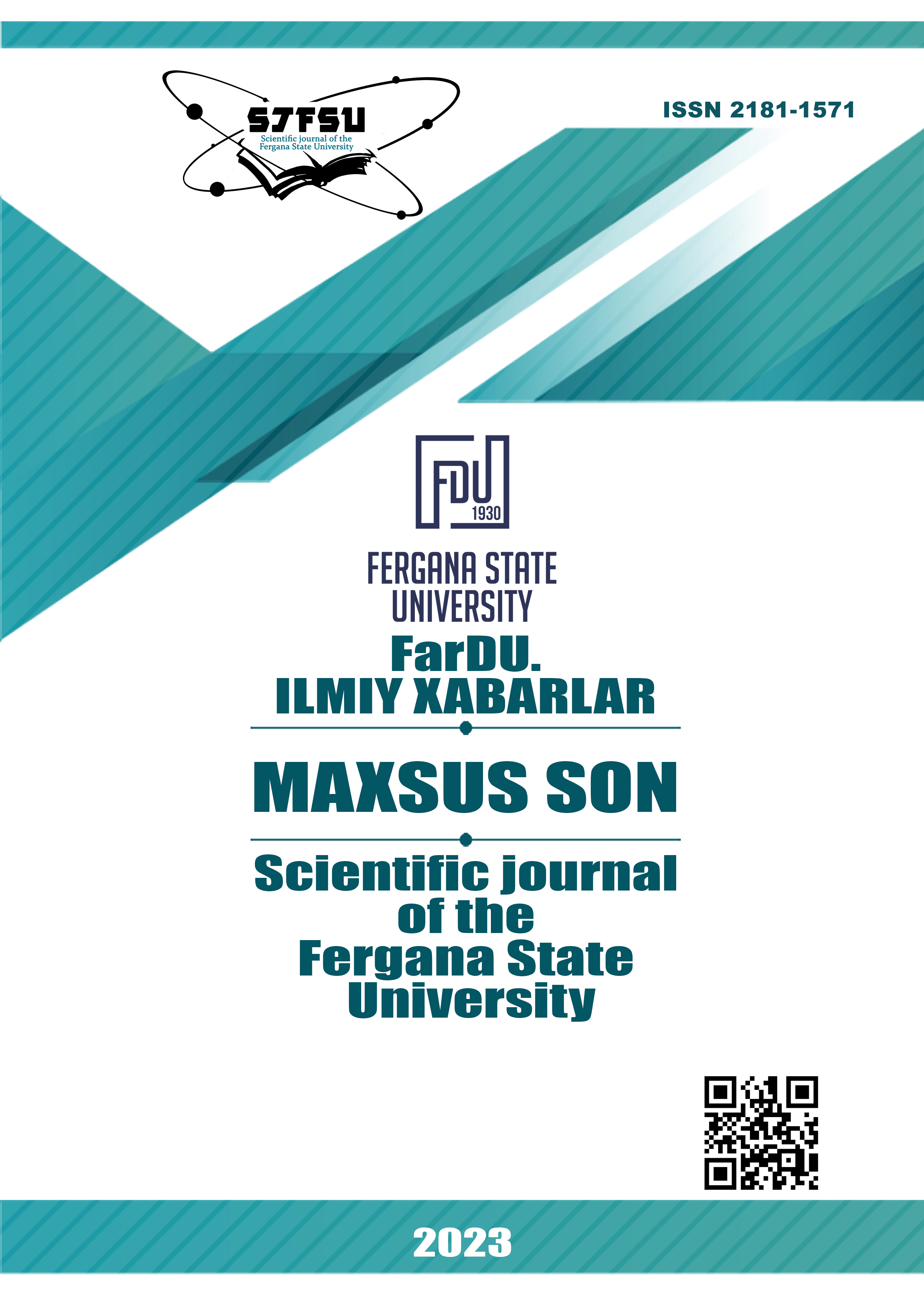ARTISTIC SPEECH POSSIBILITIES AND AUTHOR’S SKILLS IN CHARACTER CREATION
Keywords:
image speech, behavior, portraiture, character traits, personality, classification, state of mind.Abstract
In this article, the author emphasizes the issues of creating a character in a work of art. In particular, the character's way of speaking, speech, behavior, clothes, mutual description, self-description, etc., are analyzed in depth, and examples from the creative works of Stefan Zweig and Ulugbek Hamdam are given. One of the important indicators that reveal the inner world of the hero, his way of life, is the character's speech. What the hero says and how he says it is also important. Through the speech, we learn about the hero‘s nationality, social background, temperament, intelligence, abilities, level of education, about his unique characteristics.The author draws the reader's attention not only to the actions, words, thoughts, and feelings of the hero, but also to how they do it, that is, to the character of the hero. The character form means external signs of the hero‘s inner world: facial expressions, gestures, manner of speaking, tone, posture, clothes, hairstyle, even perfume and cosmetics.Writers use different methods to describe the character's inner world, character, and appearance. Which method they prefer depends on the author's writing style, the idea of the work, the genre, the criteria required by the time, and many other factors.
References
Tsveyg S. Ayol hayotidan yigirma to‘rt soat. –T.: O ‘zbekiston. 2013. –25,8,250 b.
Hamdam U. Isyon va itoat. – Toshkent. Yangi asr avlodi. 2018. –25,90,117,169 b.
Tsveyg S. Kuygan ko‘ngil faryodi. – Toshkent. Yangi asr avlodi. 2016. –67,28,47,229,47 b.
Hamdam U. Ota. – Toshkent . Yangi asr avlodi, 2020. –70,169,13,67 b.
Alijonovna, A. G. (2022). DISTINCTIVE FEATURES OF STORIES BY STEFAN ZWEIG. American Journal of Interdisciplinary Research and Development, 2, 88-94.
Alijonovna, A. G. (2022). PECULIARITIES OF STEFAN ZWEIG‘S WORKS. Confrencea, 3(3), 91-94.
Alijonovna, A. G. (2022). INTERPRETATION OF THE IMAGE OF WOMEN IN S. ZWEIG‘S SHORT STORIES" THE LETTER OF AN UNKNOWN WOMAN" AND" 24 HOURS OF A WOMAN'S LIFE". American Journal of Interdisciplinary Research and Development, 3, 39-46.
Alijonovna, A. G. (2023). S. TSVAYG “AMOK” NOVELLASIDA O ‘ZLASHGAN SO ‘ZLARNING O ‘RNI VA FUNKSIYASI. BARQARORLIK VA YETAKCHI TADQIQOTLAR ONLAYN ILMIY JURNALI, 3(5), 420-424.
Alijonovna, A. G. (2022). THE IMAGE OF THE NARRATOR IN ZWEIG‘S NOVEL" STREET IN THE MOONLIGHT". Confrencea, 3(3), 116-118.
Rustamova, I., & Asomiddinova, G. (2022). THE ISSUE OF CREATING CHARACTER IN ARTISTIC CREATION. Oriental Journal of Social Sciences, 2(03), 133-139.
Alijonovna, A. G. (2022). INTERPRETATION OF THE IMAGE OF WOMEN IN S. ZWEIG‘S SHORT STORIES" THE LETTER OF AN UNKNOWN WOMAN" AND" 24 HOURS OF A WOMAN'S LIFE". American Journal of Interdisciplinary Research and Development, 3, 39-46.
Asomiddinova, G. (2022). УЛУҒБЕК ҲАМДАМ “ОТА” РОМАНИДА ҚАХРАМОН ОБРАЗИТАЛҚИНИДА МИЛЛИЙ ДЕТАЛЛАР ВА МИЛЛИЙ ҚАДРИЯТЛАР ИФОДАСИ. Science and innovation, 1(B7), 406-409.
Asomiddinova, G. (2022). СТЕФАН ЦВАЙГ НОВЕЛЛАЛАРИДА ИНСОН РУҲИЙ ОЛАМИНИНГ ТАЛҚИНИ (“АЁЛ ҲАЁТИДАН ЙИГИРМА ТЎРТ СОАТ” НОВЕЛЛАСИ МИСОЛИДА). Science and innovation, 1(B6), 488-491.
Alijonovna, A. G. (2022). DISTINCTIVE FEATURES OF STORIES BY STEFAN ZWEIG. American Journal of Interdisciplinary Research and Development, 2, 88-94.
Asomiddinova, G. (2022). СТЕФАН ЦВАЙГ НОВЕЛЛАЛАРИДА ИНСОН РУҲИЙ ОЛАМИНИНГ ТАЛҚИНИ (“АЁЛ ҲАЁТИДАН ЙИГИРМА ТЎРТ СОАТ” НОВЕЛЛАСИ МИСОЛИДА). Science and innovation, 1(B6), 488-491.
Abdiloyev, S. O. (2023). Phraseologies In German Related To Animal Wildlife. PERFECT EDUCATION FAIRY, 1(1), 29-35.
Oxonjonovich, A. S. (2023). NEMIS TILIDA HAYVONOT DUNYOSI BILAN BOG‘LIQ BO‘LGAN FRAZEOLOGIZMLAR. BOSHQARUV VA ETIKA QOIDALARI ONLAYN ILMIY JURNALI, 3(11), 1-4.
Abdullayev, S. (2022). ACHIEVING THE RICHNESS OF ORAL AND WRITTEN SPEECH WHEN TEACHING A FOREIGN LANGUAGE. Oriental Journal of Social Sciences, 2(06), 34-39.
Qayumjonovich, A. O., & Bahodirovna, A. F. (2023). ORONIMLARNING O ‘ZIGA XOS XUSUSIYATLARI. Scientific Impulse, 2(14), 136-140.
Аbbozov, О. Q. (2021). General properties of oronims. ISJ Theoretical & Applied Science,(12), 389-391.
Qayumjonovich, А. О. (2023). In Particular of the Formation of the Oronims. Intersections of Faith and Culture: American Journal of Religious and Cultural Studies (2993-2599), 1(10), 13-17
Downloads
Published
Issue
Section
License
Copyright (c) 2024 Scientific journal of the Fergana State University

This work is licensed under a Creative Commons Attribution-NonCommercial-NoDerivatives 4.0 International License.
Most read articles by the same author(s)
- , INTERPRETATION OF THE HUMAN SPIRITUAL WORLD IN THE STORY “TWENTY-FOUR HOURS OF A WOMAN’S LIFE” OF STEFAN ZWEIG , Scientific journal of the Fergana State University: No. 6 (2024): Scientific journal of the Fergana State University ADDITIONAL COLLECTION (Social humanities sciences)

